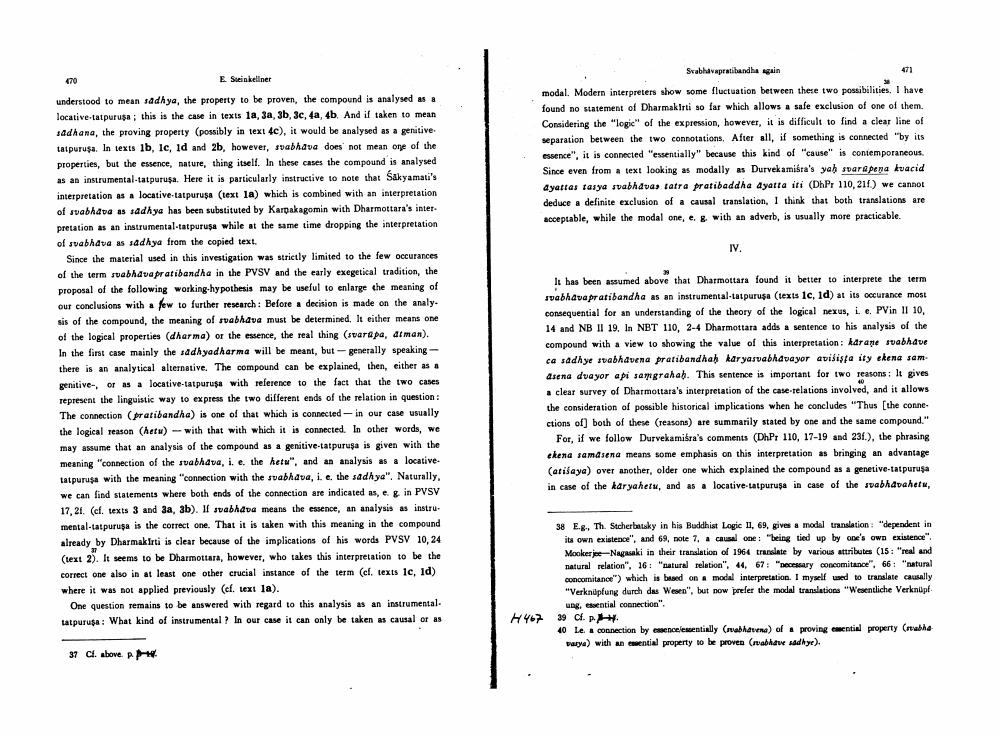Book Title: Svabhavarat Bandha Again Author(s): Ernat Steinkellner Publisher: Ernat Steinkellner View full book textPage 8
________________ E Sizinkiler Svabhavapratibandha sain modal. Modern interpreters show some fluctuation between these two possibilities. I have found no satement of Dharmakirti so far which allows a safe exclusion of one of them. Considering the "logie" of the expression, however, it is difficult to find a clear line of Meparation between the two connotations. After all, if something is connected "by its essence", it is connected essentially" because this kind of cause" is contemporaneous Since even from a text looking as modally as Durvekamista's yah arepeya kvacid ayattas tanya rabhavan tatra pratibaddha dyatta iti (DhPr 110,211) we cannot deduce definite exclusion of a causal translation, I think that both translations are acceptable, while the model one, with an adverb, is usually more practicable. IV. understood to mean radhya, the property to be proven, the compound is analysed locative tatpurusa; this is the case in texts 1a, 3a, 3b, 3c, 4a, 4b. And if taken to mean sadhana, the proving property (possibly in text 4e), it would be analysed as a genitive tatpurus. In texts lb, le, id and 2b, however, wabhave does not mean one of the properties, but the essence, nature, thing itself. In these cases the compound is analysed as an instrumental tatpurusa. Here it is particularly instructive to note that Sakyamati's interpretation as a locative tatpurusa (text la) which is combined with an interpretation of sabhava as sadaya has been substituted by Karpakagomin with Dharmottara's inter pretation as an instrumental tatpurusa while at the same time dropping the interpretation of swabhava as sadhya from the copied text. Since the material used in this investigation was strictly limited to the few securances of the term rabhava pratibandha in the PVSV and the early exegetical tradition, the proposal of the following working-hypothesis may be useful to enlarge the meaning of our conclusions with a few to further research: Before decision is made on the analy. sis of the compound, the meaning of rabhava must be determined. It either means one of the logical properties (dharma) or the essence, the real thing (muarepa, diman). In the fini care mainly the sadhyadharma will be meant, but generally speaking there is an analytical alternative. The compound can be explained, then, either as a genitive, or as a locative-tatpurusa with reference to the fact that the two cases represent the linguistic way to express the two different ends of the relation in question: The connection pratibandha) is one of that which is connected in our case usually the logical reason (het) - with that with which it is connected. In other words, we may assume that an analysis of the compound as a genitive tatpurua is given with the meaning "connection of the abhave, ie the hetu", and an analysis as a locativetatpurusa with the meaning "connection with the suabhava, i.e. the sadhya". Naturally we can find statements where both ends of the connection are indicated as, e. & in PVSV 17.21. (d. texts 3 and 3a, 3b). I wablada means the essence, an analysis as instrumental-atpurusa is the correct one. That it is taken with this meaning in the compound already by Dharmakirti is clear because of the implications of his words PVSV 10,24 (text 2). It seems to be Dharmottar, however, who takes this interpretation to be the correct one also in at least one other crucial instance of the term (cl. texts 1c, id) where it was not applied previously (cf. text la). One question remains to be answered with regard to this analysis an instrumental Latpurusa : What kind of instrumental? In our case it can only be taken as causal or as It has been assumed above that Dharmottara found it better to interprete the term svabhava pratibandha as an instrumental tatpurusa (texts 1c, id) at its surance most consequential for an understanding of the theory of the logical nexus, Le PVin II 10, 14 and NB II 19. In NBT 110, 2-4 Dharmottara adds a sentence to his analysis of the compound with a view to showing the value of this interpretation : karane madhave ca sadhye vabhavana pratibandhah karyasvabhavayor avidisaity skena sam asena dvayor api samgrahah. This sentence is important for two reasons: It gives clear survey of Dharmottara's interpretation of the case relations involved, and it allows the consideration of possible historical implications when he concludes "Thus [the connections of both of these (reasons) are summarily stated by one and the same compound." For, if we follow Durvekamisra's comments (DhP: 110, 17-19 and 231.), the phrasing kena ramdiena means some emphasis on this interpretation as bringing an advantage Carilaya) over another, older one which explained the compound as a genetive-tatpurusa in case of the karyaher, and as locative tatpurus in case of the wabhavahetu, 38 E Th Stcherbatsky in his Buddhist Logic 1. 69 gives a model translation dependent in its own existence", and 69, note 7 causal one: "being tied up by one's own existence. Mookerje Negaki in their translation of 1964 translate by various attributes (15: "real and natural relation". 16: "natural relation". 44, 67: "ecary concomitance", 66: "natural concomitance") which is based on model interpretation. I myself and to translate causally Verknüpfung durch das Wer", but now peeler the medial translation "Wesentliche Verknüpf ung. sential connection". 39 d. p . 40 Le connection by eeeeentially (rabharna) of proving cantial property naha mary) with an ential property to be proven (nawe Aadhye). H467 37 Cl. abovePage Navigation
1 ... 6 7 8 9 10 11
